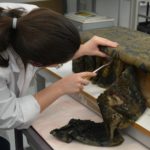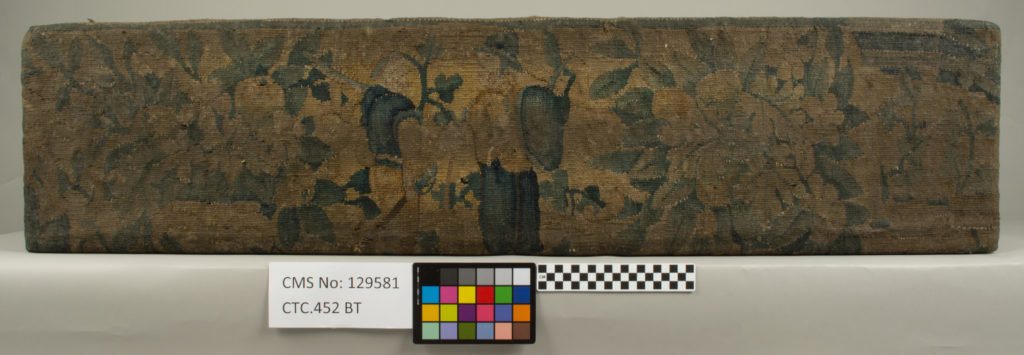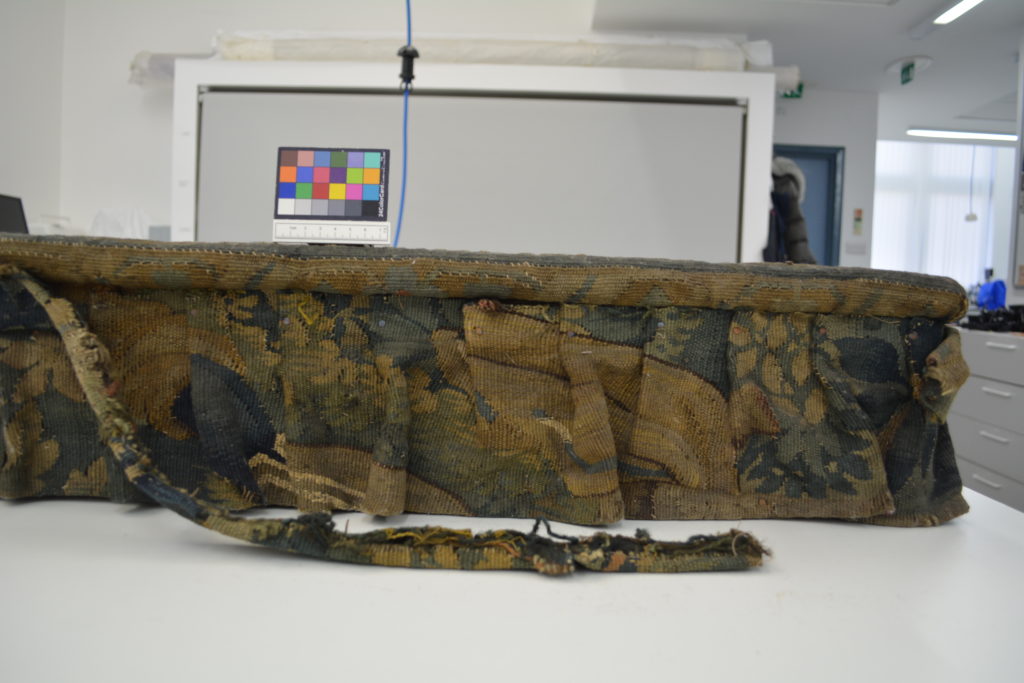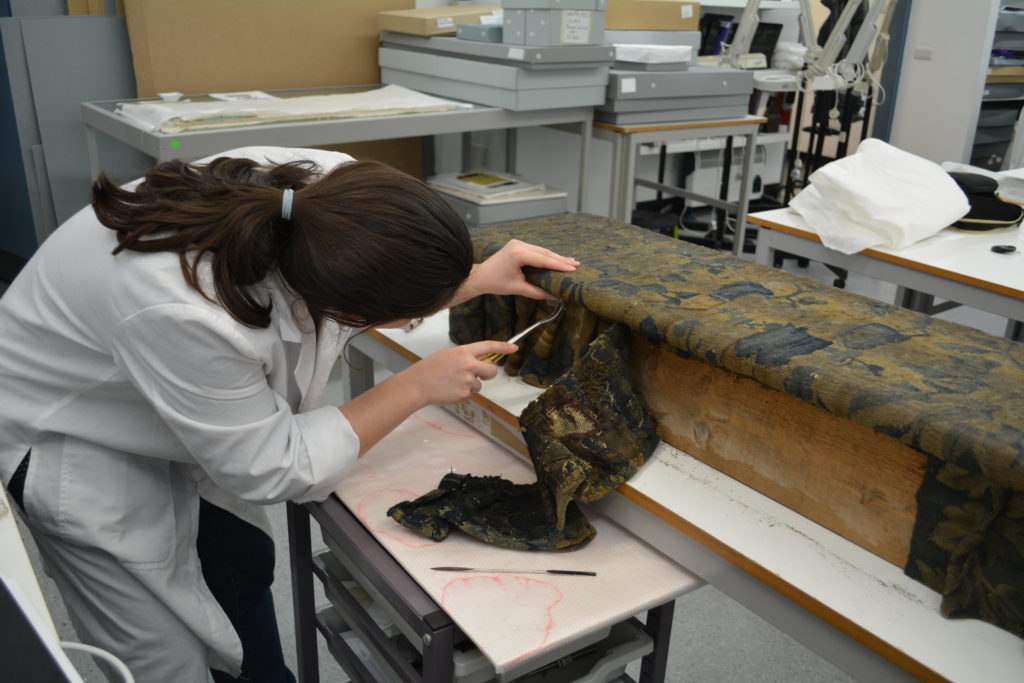
by Kayla Silvia, 2nd Year student, MPhil Textile Conservation.
Introduction
In the final semester of the second year at the Centre for Textile Conservation (CTC), students have the opportunity to focus on a complex conservation treatment. My artifact is a tapestry covered stool from Knole, a National Trust property in Kent. Knole is still inhabited by the Sackville family, as it has been for thirteen generations and over 400 years [1]. It boasts the largest collection of original Stuart furniture, including those from the reigns of King Charles I, King James II, King Charles II, King William III and Queen Mary II, and Queen Anne [2]. Treatment of the stool at the CTC stemmed out of a larger conservation project at Knole and my interest in specializing in upholstery conservation following a summer placement at the Knole Conservation Studio under Heather Porter, Senior Conservator (Upholstery).

Inspired by Knole: Conservation Project
As an aging estate, Knole had endured centuries of dust and periods of pest infestation. In order to rectify the many conservation issues and save this unique collection, a massive conservation and refurbishment project began in 2012 [3]. The National Lottery Heritage Fund partially funded a multi-million conservation and building project called Inspired by Knole[4] [5]. A portion of the funding went toward the construction of a conservation studio, which focused on preserving artifacts from the house. On 2 March 2019 the project was officially completed and Knole fully reopened to the public. The conservation studio now provides a conservation service to National Trust properties nationwide.
The Stool
I was asked to treat the tapestry covered stool so that it could be returned to open display in the showrooms at Knole. The tapestry was extremely soiled from being on display and there were numerous areas that were weak and required support. Curators at Knole thought that the tapestry dated from the 17th century but the stool was created much later in the 19th century. In the artifact’s present condition, it was difficult to corroborate this information.


I was tasked with cleaning and stabilizing the tapestry, which required its removal from the wooden frame. Due to the complexity of upholstery structures that have multiple layers underneath the show cover, upholstery is rarely disassembled. Therefore, this treatment provided me with a rare opportunity to become familiar with this aspect of upholstery conservation since the tapestry could not be effectively cleaned or stabilized in situ. To meet the aims of the treatment I proposed disassembly, cleaning, stabilization, and reassembly of the tapestry to the stool. In this installment, I will only discuss the disassembly of the stool and the other steps will be covered in subsequent posts.
Disassembly of the Stool
Before disassembly began I carefully documented the location of the upholstery tacks that were visible using diagrams, templates, and photographs. Knole requested that the tacks be saved and reused in the reassembly of the stool since the tacks are original. I first removed the trim since it was the outermost layer of the tapestry, then the valence or skirt, and finally the seat. I removed the tacks holding the trim with traditional upholstery tools and placed a piece of Melinex® underneath the tacks to prevent damage to the tapestry during removal – it was a slow and tricky process requiring a delicate balance of strength and sensitivity.


Throughout the process I updated my initial diagrams and templates with the location of other tacks previously hidden by the layer being removed. I also photographed the stool after removing each layer. During removal, there was evidence of insect damage to both the textile and wood but fortunately no evidence of current infestation. The tacks were all collected and inserted into foam with their positions marked so that I can place the tacks back into their original holes later. The majority of the tacks were machine-made steel, but some wire tacks were also present.


To be continued in Part II…
Tune in for the next blog to witness the visual transformation of the tapestry fragments after cleaning!
For further information about Knole and the Conservation Studio please see the links below:
Knole: https://www.nationaltrust.org.uk/knole
Conservation Studio: https://www.nationaltrust.org.uk/knole/conservation-studio
Inspired by Knole: https://www.nationaltrust.org.uk/knole/features/a-year-of-change-at-knole
History of Knole: https://www.nationaltrust.org.uk/knole/features/a-brief-history-of-knole
Bibliography
Drury, Martin. “A Crumbling Inheritance: Textiles and the National Trust.” In Textiles in Trust, edited by Ksynia Marko, 1 – 7.London: Archetype Publications in association with the National Trust, 1997.
Gill, Kathryn. “The Development of Upholstery Conservation as a Practice of Investigation, Interpretation and Preservation.” Studies in Conservation 49, no. sup1 (2004): 3-22.
The Institute of Conservation. “State-of-the-art Conservation Studio Opens at Knole”, https://icon.org.uk/news/state-of-the-art-conservation-studio-opens-at-knole. Accessed March 9, 2019.
National Trust. “A time of change at Knole”, https://www.nationaltrust.org.uk/knole/features/a-year-of-change-at-knole. Accessed March 9, 2019.
Sackville-West,
Robert. Inheritance: The Story of Knole and the Sackvilles. London: Bloomsbury, 2010.
[1] Robert Sackville-West, Inheritance: The Story of Knole and the Sackvilles (London: Bloomsbury, 2010), 1.
[2] Martin Drury, “A Crumbling Inheritance: Textiles and the National Trust” in Ksynia Marko (ed), Textiles in Trust (London: Archetype Publications in association with the National Trust, 1997), 1 – 7, at 4 – 5.
[3] “A time of change at Knole”, National Trust, https://www.nationaltrust.org.uk/knole/features/a-year-of-change-at-knole (accessed March 9, 2019).
[4] National Trust, “A time of change at Knole.”
[5] “State-of-the-art Conservation Studio Opens at Knole”, The Institute of Conservation, https://icon.org.uk/news/state-of-the-art-conservation-studio-opens-at-knole (accessed March 9, 2019).

